|
|
KEY FIGURES
 |
|  |
 | August 2003 | September 2003 | October 2003 | Sep 03 to Oct 03 |  |
 | $m | $m | $m | % change |  |
Trend |  |
|  |
| Balance on goods & services | -2,107 | -2,032 | -1,910 | 6 |  |
| Credits (exports of goods & services) | 11,438 | 11,512 | 11,624 | 1 |  |
| Debits (imports of goods & services) | 13,545 | 13,544 | 13,534 | - |  |
Seasonally Adjusted |  |
|  |
| Balance on goods & services | -1,957 | -2,250 | -1,648 | 27 |  |
| Credits (exports of goods & services) | 11,592 | 11,554 | 11,755 | 2 |  |
| Debits (imports of goods & services) | 13,549 | 13,804 | 13,403 | -3 |  |
|  |
| - nil or rounded to zero (including null cells) |
 |  |  |  |  |  |
Balance on goods and services
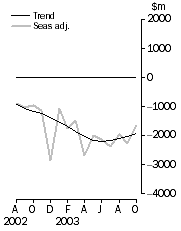
|  |
KEY POINTS
TREND ESTIMATES
- The provisional trend estimate of the balance on goods and services was a deficit of $1,910m in October 2003, a decrease of $122m (6%) on the deficit in September.
- Goods and services credits rose $112m to $11,624m. Goods and services debits fell $10m to $13,534m.
SEASONALLY ADJUSTED ESTIMATES
- In seasonally adjusted terms, the balance on goods and services was a deficit of $1,648m in October, a decrease of $602m (27%) on the deficit in September.
- Goods and services credits rose $201m (2%) to $11,755m. Services credits rose $211m (8%), rural goods rose $32m (2%) and non-rural and other goods fell $42m (1%). The increase in services credits was partly due to international visitors attending the Rugby World Cup.
- Goods and services debits fell $401m (3%) to $13,403m, with goods debits down $457m (4%) and services debits up $56m (2%). Consumption goods fell $156m (4%), intermediate and other goods fell $163m (3%) and capital goods fell $138m (5%).
ORIGINAL ESTIMATES
- In original terms, the October balance on goods and services was a deficit of $3,147m, a decrease of $33m (1%) on the deficit in September. The decreased deficit was the result of a $459m (4%) increase in exports of goods and services, mostly offset by a $426m (3%) increase in imports of goods and services.
NOTES
CHANGES IN THIS ISSUE
Seasonal Factors
Seasonally adjusted and trend estimates of the balance on goods and services have been revised as a result of the seasonal re-analysis which takes account of additional data that have become available since the previous re-analysis.
Revised historical and new forward seasonal factors are available in the electronic version of this publication (see 5368.0, Table 19, for monthly seasonal factors). Existing subscription clients to this data service should contact Kevin Yeadon on 02 6252 6255 or e-mail .
FEATURE ARTICLES
A feature article on Australia's Exporters, 2002-03 has been released on the ABS web site concurrently with the release of this publication. The article is the third in a series analysing the characteristics and international trading activities of Australia's exporters and importers, based on the Australian Business Number (ABN). The earlier articles related to analyses for the July to December 2001 and 2001-02 reference periods respectively.
The number of Australian exporters of goods and services in 2002-03 was estimated to be 31,174, a fall of 0.9% from the estimate of 31,450 for 2001-02. This estimate is consistent with the 3.2% fall in the total value of exports of goods and services from $153.3b in 2001-02 to $148.4b in 2002-03. Information on importers for 2002-03 will be included in a separate article to be released on the web site on 9 January 2004. To access these articles on the web site select: Themes then International Trade then Topics of Interest.
A feature article on the Statistical Treatment of Economic Activity in the Timor Sea was included in the September quarter 2003 issue of Australian National Accounts: National Income, Expenditure and Product (cat. no. 5206.0), released on 3 December 2003.
CAUTIONARY NOTE
The tables in this publication are presented on two bases. Tables 1-6 contain estimates of Australia's international trade in goods and services which have been adjusted for coverage, valuation and timing to a balance of payments basis. Tables 7-10 contain estimates of merchandise exports and imports based on Australian Customs Service records. Paragraph 5 of the Explanatory Notes provides an explanation of the difference between these bases.
INQUIRIES
For further information about these and related statistics, contact the National Information and Referral Service on 1300 135 070 or Artur Andrysiak on Canberra 02 6252 6792.
ADDITIONAL TABLES ON AUSSTATS
TABLES AVAILABLE ON AUSSTATS
12 Merchandise exports by Broad Economic Category (BEC)
13 Merchandise exports by industry of origin (ANZSIC)
14 Merchandise imports by Broad Economic Category (BEC)
15 Merchandise imports by Balance of Payments Broad Economic Category (BoPBEC)
16 Merchandise imports by industry of origin (ANZSIC)
17 Merchandise exports, state by country and country groups
18 Merchandise imports, state by country and country groups
19 Monthly forward seasonal adjustment factors
ANALYSIS AND COMMENTS
BALANCE ON GOODS AND SERVICES
The trend estimate of the balance on goods and services in October 2003 was a deficit of $1,910m, a decrease of $122m (6%) on the deficit in September.
In seasonally adjusted terms, the balance on goods and services in October 2003 was a deficit of $1,648m, a decrease of $602m (27%) on the deficit in September.
EXPORTS OF GOODS AND SERVICES
The trend estimate of goods and services credits rose $112m (1%) in October to $11,624m.
In seasonally adjusted terms, goods and services credits rose $201m (2%) in October to $11,755m. Rural goods rose $32m (2%), while non-rural and other goods fell $42m (1%). Services credits rose $211m (8%), partly due to international visitors attending the Rugby World Cup.
GOODS CREDITS
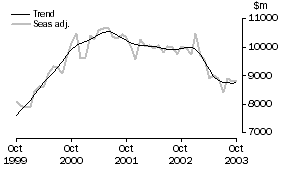
SERVICES CREDITS
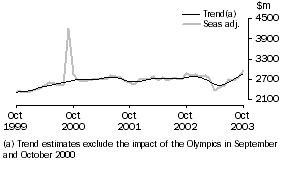
Rural goods
The trend estimate of rural goods rose $31m (2%) to $1,837m.
In seasonally adjusted terms, rural goods increased $32m (2%) to $1,903m.
Rural goods, in original terms, rose $122m (7%) to $1,971m.
The main contributor to the increase in the seasonally adjusted series was cereal grains and cereal preparations, up 35%, in contrast to the average September to October fall of 2% over the previous three years. This was partly offset by a fall in other rural goods, down $3%, compared with the average September to October rise of 7%.
Non-rural and other goods
The trend estimate of non-rural and other goods exports fell $7m to $6,923m.
Seasonally adjusted, non-rural and other goods fell $42m (1%) to $6,887m.
In original terms, non-rural and other goods fell $48m (1%) to $7,182m.
Contributing to the decrease in the seasonally adjusted series were:
- other goods, up $1m (0%), compared with the average September to October rise of 29% over the previous three years
- other non-rural, down $99m (12%), in contrast to the average September to October rise of 8% over the previous three years
- transport equipment, up $11m (2%), compared with the average September to October rise of 24% over the previous three years
- other mineral fuels, down $153m (18%), compared with the average September to October fall of 7% over the previous three years.
Partly offsetting these decreases was a rise in metal ores and minerals, up $126m (11%), compared with the average September to October rise of 6% over the previous three years.
IMPORTS OF GOODS AND SERVICES
The trend estimate of goods and services debits fell $10m in October to $13,534m.
In seasonally adjusted terms, goods and services debits fell $401m (3%) to $13,403m.
Goods debits fell $457m (4%) while services debits rose $56m (2%).
GOODS DEBITS
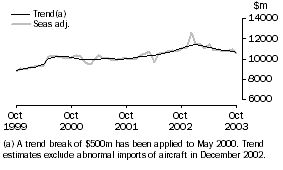
SERVICES DEBITS
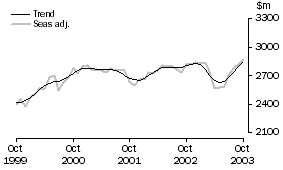
Consumption goods
The trend estimate of imports of consumption goods fell $5m to $3,439.
In seasonally adjusted terms, imports of consumption goods fell $156m (4%) to $3,445m.
Consumption goods, in original terms, rose $122m (3%) to $4,105m.
Contributing to the fall in the seasonally adjusted series were:
- non-industrial transport equipment, down $60m (5%), in contrast to an average September to October rise of 4% over the previous three years
- consumption goods n.e.s., up $87m (7%), compared with an average September to October rise of 16% over the previous three years
- food and beverages, up $25m (5%), compared with an average September to October rise of 21% over the previous three years
- textiles, clothing and footwear, down $29m (6%), in contrast to an average September to October rise of 8% over the previous three years.
Capital goods
The trend estimate of imports of capital goods fell $38m to $2,511m.
Seasonally adjusted, capital goods imports decreased $138m (5%) to $2,403m.
Imports of capital goods, in original terms, rose $62m (2%) to $2,709m.
Contributing to the fall in the seasonally adjusted series were:
- civil aircraft, down $68m (24%), in contrast to strong September to October rises over the previous three years
- machinery and industrial equipment, up $34m (4%), compared with an average September to October rise of 17% over the previous three years
- ADP equipment, up $6m (1%), compared with an average September to October rise of 6% over the previous three years
- industrial transport equipment, up $24m (8%), compared with an average September to October rise of 14% over the previous three years.
Intermediate and other goods
The trend estimate of imports of intermediate and other goods decreased $23m to $4,733m.
Seasonally adjusted, intermediate and other goods imports fell $163m (3%) to $4,682m.
Imports of intermediate and other goods, in original terms, increased $218m (4%) to $5,240m.
Contributing to the fall in the seasonally adjusted series were:
- other merchandise goods, down $79m (49%), in contrast to strong September to October rises over the previous three years
- fuels and lubricants, down $71m (9%), in contrast to an average September to October rise of 33% over the previous three years
- goods for processing, down $98m (26%), in contrast to an average September to October rise of 44% over the previous three years.
Partly offsetting these effects were:
- organic and inorganic chemicals, up $153m (75%), in contrast to an average September to October fall of 12% over the previous three years
- processed industrial supplies, up $119m (12%), compared with an average September to October rise of 9% over the previous three years.
|
 Print Page
Print Page
 Print All
Print All